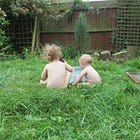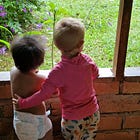When should you wash a baby's hair?
How can we set children up for healthy, comfortable heads?
Picture this:
A harsh dental-drill whine pierces the still, humid air as a single ‘six-o’clock-bee’ begins its warning of the impending sunset. Very quickly, that first cicada’s performance becomes a duet, a quartet, and then within thirty seconds the air is filled with the shrill buzz of thousands.
Other bugs are noticing the dusk too. The army ants are on the move, marching along a channel under our hut. My six-year-old is lying on her front on the rough wood floor, watching them through the gaps. I'm watching a bug too. It's black and crawling about malevolently in her blonde hair. And I know exactly what it is.
Head lice evolve to match the colour of the hair in a community, so at least these South American ones are easy to spot. Her fair hair runs smoothly through my fingers as I carefully comb coconut oil through it the next day, squashing lice and eggs between my thumb nails. I separate out the tresses, braiding the hair tightly against her scalp. At least that way, I figure, the head lice won’t be able to climb on to anyone else. She’ll look beautiful and I’ll look like a mum who takes very good care of her kids.
After school, chatting with a few women from the village, I hear the high voices of my two children well before I see them emerge from the rainforest. My daughter’s hair is still in the braids. She looks so tidy. I go forward to greet them. As I do so, I hear one woman say to the other, “Why is that girl’s hair tied up like that?” The other responds wisely, “Ah. She must have head lice.”

Most of us shampoo our hair very frequently
Whether we want it to or not, our hair signals all kinds of things to the people around us: our age and health, sure, but also the effort we’ve put into it, the degree to which we comply with social norms, the tribe or group we identify with, sometimes the bugs we carry within it, and often much more. We have a long history of using our hair as a way to communicate.
For many of us, to make our hair look how we want involves washing with shampoo, conditioner, and then towel-drying or blow-drying. Frequencies vary, with many people performing the ritual between weekly and daily, and some even more often. One survey found that the average UK woman spends 52 minutes on her hair every day. (I can't help but imagine that if you spend that long on your hair, you'd be more likely to want to answer a survey about hair-care and hence the sample is biased, but who knows?).
So why is human hair so much work? Not one of the other 6000 types of hairy mammals on earth devolves into an itchy, greasy, flaky mess if they don't use shampoo, so what's going on?
The first thing scientists checked was ‘Is this need for frequent shampooing really real (or is it just a mass delusion held by billions of women still over the world)?’ A Chinese study looked at the scalp and hair health of Chinese people who washed their hair twice weekly, and then the researchers got them to wash their hair daily. They found improvements on every measure that they reported.
Which implies that, not only have humans evolved to need shampoo, but also to need it every single day. Which…is a very strange thing for a species to have done.
Another possible explanation came from a paper out of Nigeria. They similarly compared the scalps of people who shampooed their hair once a week to once-a-day-ers. They found similar effects to the Chinese team, but then they started looking in the other direction. What about once a fortnight? Once a month? Once every two months? Four?
Amazingly, although things got worse out to about a month, after that they got better again on every metric. Every. Metric.
This team didn't invite participants who never shampooed their hair, which is a pity. Online interviews (Reddit and the like) suggest that they may have found a population with heads every bit as comfortable and beautiful as those who do it every day.
But how? How can more frequent washing be better and also less frequent washing be better?
But scalps evolved without shampoo
The answer lies in how we alter our scalp system when we wash our hair.
In its unaltered state, the entire scalp system is balanced. Your scalp cells (epithelial cells) grow, become filled with keratin, encased in structured lipids (a waxy, fatty matrix), and turn into a robust, waterproof barrier. We don’t want too many or too few layers of cells, so the glands around the hair secrete a solvent called sebum, which helps the cells be shed at exactly the right rate. And they're shed individually. No visible flaking here.
That sebum also provides food for a wide range of microbes, living in a biodiverse ecosystem. Fungi called Malassezia live alongside many bacterial species. And, in the way that some neighbours do, they keep each other in check, by restricting each other’s food, by making their territory just how they like it, and even by stimulating the body to release its own antimicrobial peptides. No one microbe can overgrow. The mildly irritant substances that some microbes produced are neutralised by the antioxidants in the sebum. The robust, waterproof skin barrier keeps any bits of microbe out, so the scalp feels comfortable and calm.
The hair is also fully coated with sebum, so there are no visible oily roots. The sebum is moved over the scalp and hair through movement, grooming, or brushing. The hair feels smooth and sleek, not oily, and not fluffy.
In summary: smooth, non-flaky, and non-itchy.
What about with shampoo?
Given that so much of the natural system I just described is based on oils, adding something specifically designed to remove oil (ie. the surfactant which is the major component of shampoo) seems like it should put us in a completely different place. From first principles, if we’d never used shampoo, we might expect pain and itching immediately.
But that’s not what happens, is it? The output is smooth, non-flaky, non-itchy hair. There’s apparently no difference between the two states.
But that similarity is deceiving. It’s kind of like the similarity between a fine china plate that is whole and undamaged because it is resting on the table, and a fine china plate that is whole and undamaged because someone has just removed the table from underneath it and it hasn’t yet hit the floor. Both are whole, undamaged plates.
However, in both our china plate analogy and in real life, there’s trouble rapidly approaching. In fact, it’s only four steps away:
First, as we might expect, the surfactant in the shampoo does its job and allows oil and water to mix. This removes sebum from the hair shaft and gives it a sleek, shiny look. Lovely. It also makes the structured lipid barrier between the skin cells easier to wash away, and wash away some of them do. Less lovely.
Second, the surfactant also rips the oil cover off the outside of many of the bacteria and fungi that live on the scalp (because humans are an unavoidable ecosystem). Having their skin ripped off, understandably, kills a bunch of the microbes and really annoys the rest. This shifts the scalp microbiome from nicely-balanced and self-limiting, to out-of-control and dominated by that fungus Malassezia.
As soon as your body realises that your scalp barrier has been trashed (which it does by sensing that too much water is now evaporating out through the damaged barrier. It’s a dry, tight, uncomfortable sort of feeling), it does its best to thicken up the barrier again by pumping out new skin cells. However, these new recruits don’t even have time to get their keratin armour on before they’re dead or dying from the dry, non-oily conditions. They flake off.
Out-of-control Malassezia (without any competition from other microbes any more) happily chews up all of the fresh new sebum that’s still being released) and excretes irritating chemicals as waste. These irritating compounds easily pass through the wrecked barrier (less structured lipid AND fewer layers AND less keratin in each layer) and, as their name suggests, irritate the tissue underneath. Bits of all the dead microbes also penetrate into the tissue and make the irritation much worse.
The trouble that is fast approaching is of the itchy, reddened, flaky, hyper-sebum-greasy variety.
But, just when the metaphorical plate looks like it’s about to hit the floor and shatter into a million pieces, someone goes and digs a hole under it by re-shampooing the scalp, resetting all of those ticking clocks and buying themselves some more time before everything gets horrible. Rinse and repeat. And repeat. And repeat.
Phew.
Who knew our scalp was so complex?
Also, who’s itching their head at this point? This is an unavoidable consequence of reading about scalps. I apologise.
Can you go from frequent washing to never washing?
The picture I’ve painted above implies that once you’ve started, you need to continue forever. That is not true. It’s shampoo, not melange. It can, however, be uncomfortable to wait for the skin to repair itself. The unusual irritant sebum can get pretty damned itchy. Nevertheless, many people do have comfortable, healthy scalps without ever washing them with shampoo. It’s well worth a quick Google - there are an enormous variety of ways to wash, clean, and groom hair in ways that reduce or remove sebum without using surfactants. There are also benefits, some people report thicker, more strongly coloured hair. However, while that is what I’d expect to happen from a less damaged scalp, it is not scientifically proven.
If you don’t like washing your hair, or if you don’t mind going through a period of variably unpleasant scalp and hair symptoms, maybe it’s something to try if you’re curious. There are various weaning off options and step-down programs online. You don’t need to go cold turkey.
But if you don’t have problems with your scalp and you wash your hair frequently, you’ve likely found a balance that works for you. It’s probably not worth changing it. As an adult, you’ll have been learning how to manage your own microbes and specific level of sebum production in a way that feels good for you.
What does this mean for children?
OK, so everything above has been written about adults. What’s different in children? Children produce much less sebum than adults. That’s why their hair doesn’t get greasy. Sebum production starts to increase around the age of nine or so.
But most parents start applying shampoos to their children from a very young age. There’s a reason that many companies have invested in non-stinging shampoos. Washing your hair feels HORRIBLE as a child. The soap goes in your eyes, up your nose, and you have water poured over your hair, and you definitely don’t think you need it.
So what should we do to give children the best chance of healthy, itch-free, comfortable, attractive heads of hair?
Don’t introduce shampoo until you need it. See how long your child can go without. The longer they do this, the more resilient the microbiome will be, and the less they will end up in a vicious cycle that’s not of their own making.
Use water for dirt that’s water soluble, and coconut oil for dirt that’s oil soluble. For example - cradle cap. This is a brownish scaling and discolouration. Its function is unknown (though, personally, I wonder if it’s a form of sunscreen to protect the baby’s head before its hair is thick enough. After all, a baby’s skull is thin enough that they can literally sunburn their brain on a bright day). Coconut oil is your friend here. It helps dissolve it, and it also acts as a prebiotic for good scalp bacteria.
Brush long hair frequently. We often forget that brushing is a type of cleaning - in fact, it’s the only cleaning method that most insects use.
Battling head lice infections? The NHS recommends combing through the hair every five days with conditioner, but I can tell you that coconut oil works just as well and doesn’t need to be washed out. And the smell of coconut makes that bug-hunting slightly less unpleasant.
Consider dry shampoo. These are usually made of rice-starch or cornstarch, which absorbs sebum to keep it off the skin, without hurting the microbes and making them inflammatory. Many skin-care products contain oats as these are prebiotic for skin bacteria, and the starch in dry shampoo may have a similar effect.
Use shampoo when it’s needed, but not before. It’s not wrong to use shampoo, but it’s not worth using a product that alters so many parts of the normal system unless you really need it. Use it thoughtfully and evaluate whether or not it’s done what you wanted it to do.
Everyone loves a wet sudsy baby. But wet sudsy babies very rarely ask to have their hair washed. Let’s keep shampoo away from children to allow them to grow stable, resilient scalps. They’ll need them, to be able to survive all of the hair-styling experiments of the teenage years without receiving a legacy of scalp discomfort through their adult lives.
We don’t need to add shampoo to babies. Their scalps work just fine.
Want to hear my partner and I discuss our experiences of managing scalp health in children? We have a podcast where we use the topic from the previous post and give context and examples to help bring it to life. There’s also a weekly news section where we dive into interesting research into child development from the previous week.
This is the sound of Sunday evenings in our house!
You may also like:
Notes
The average UK woman apparently spends 52 minutes on their hair every day: https://geehair.com/blogs/hair-blog/hair-care-industry-statistics-2021-2022
The health of your scalp affects the quality and quantity of your hair: https://journals.lww.com/ijot/fulltext/2018/10060/scalp_condition_impacts_hair_growth_and_retention.3.aspx
Paper on ‘How often should we wash our hair?” Its conclusion “as often as possible”: https://pmc.ncbi.nlm.nih.gov/articles/PMC8138261/
Paper on scalp health with different hair-washing intervals in Nigerian women. https://journals.lww.com/npmj/fulltext/2023/30010/a_community_based_study_of_hair_care_practices,.8.aspx
Sebum secretion in people at different ages: https://pubmed.ncbi.nlm.nih.gov/448169/
This study reported that many baby shampoos sold in Turkey contain substances that aren’t recommended to be used on babies: https://manage.effectpublishing.com/uploads/articles/873338546.pdf
Coconut oil appears to support scalp commensal microbes: https://pmc.ncbi.nlm.nih.gov/articles/PMC8012655/







Great article, as always! About seven years ago I started making my own soap and cosmetics. Once I understood saponification, it became clear to me that removing all of the oils produced by my body, only to reintroduce non-native oils in the form of creams and conditioners, was madness. I stopped using shampoo and never looked back; I brush and scrub instead, trusting in the power of almighty water to do its job. My beard is a different sort of ecosystem, so I use a bit of argan oil to keep it from getting itchy. I also like neem for various purposes, including scalp care.
It's amazing to me that we create problems for ourselves only to be sold solutions at a premium. The human body is such a wonder; it's important to understand our natural systems before we start messing with them in the name of progress.
I used to have super greasy hair and dandruff, and no dandruff shampoo would help. If I went longer than a day without shampoo, my hair would be greasy and gross. It would be greasy even when I woke up in the morning.
But I stopped shampoo completely about 7 years ago, and now my dandruff is gone and my hair isn’t greasy anymore even if I go 48 hours or longer without a shower.
I still wash my hair. I just put it under the shower and scrub with my fingers. I don’t use soap or shampoo though.
There was a multi week period where it wasn’t much fun where my head adjusted, but it wasn’t that hard of an adjustment. Just take more showers and wash the grease out with plain water and you’ll be fine.